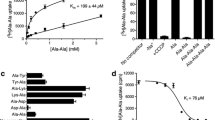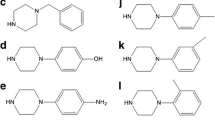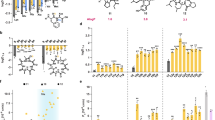Abstract
Purpose. To evaluate the cellular permeation characteristics and the chemical and enzymatic stability of phenylpropionic acid-based cyclic prodrugs \(\underset{\raise0.3em\hbox{$\smash{\scriptscriptstyle-}$}}{1} \) and \(\underset{\raise0.3em\hbox{$\smash{\scriptscriptstyle-}$}}{2} \) of opioid peptides [Leu5]-enkephalin (H-Tyr-Gly-Gly-Phe-Leu-OH) and DADLE (H-Tyr-D-Ala-Gly-Phe-D-Leu-OH), respectively.
Methods. The rates of conversion of cyclic prodrugs \(\underset{\raise0.3em\hbox{$\smash{\scriptscriptstyle-}$}}{1} \) and \(\underset{\raise0.3em\hbox{$\smash{\scriptscriptstyle-}$}}{2} \) to [Leu5]-enkephalin and DADLE, respectively, in HBSS, pH 7.4 (Caco-2 cell transport buffer) and in various biological media having measurable esterase activity were determined by HPLC. The cell permeation characteristics of [Leu5]-enkephalin, DADLE, and cyclic prodrugs \(\underset{\raise0.3em\hbox{$\smash{\scriptscriptstyle-}$}}{1} \) and \(\underset{\raise0.3em\hbox{$\smash{\scriptscriptstyle-}$}}{2} \) were measured using Caco-2 cell monolayers grown onto microporus membranes and monitored by HPLC.
Results. In HBSS, pH 7.4, cyclic prodrugs \(\underset{\raise0.3em\hbox{$\smash{\scriptscriptstyle-}$}}{1} \) and \(\underset{\raise0.3em\hbox{$\smash{\scriptscriptstyle-}$}}{2} \) degraded to [Leu5]-enkephalin and DADLE, respectively, in stoichiometric amounts. In 90% human plasma, the rates of disappearance of cyclic prodrugs \(\underset{\raise0.3em\hbox{$\smash{\scriptscriptstyle-}$}}{1} \) and \(\underset{\raise0.3em\hbox{$\smash{\scriptscriptstyle-}$}}{2} \) were slightly faster than in HBSS, pH 7.4. These accelerated rates of disappearance in 90% human plasma could be reduced to the rates observed in HBSS, pH 7.4, by pretreatment of the plasma with paraoxon, a known inhibitor of serine-dependent esterases. In homogenates of Caco-2 cells and rat liver, accelerated rates of disappearance of cyclic prodrugs \(\underset{\raise0.3em\hbox{$\smash{\scriptscriptstyle-}$}}{1} \) and \(\underset{\raise0.3em\hbox{$\smash{\scriptscriptstyle-}$}}{2} \) were not observed. When applied to the AP side of a Caco-2 cell monolayer, cyclic prodrug \(\underset{\raise0.3em\hbox{$\smash{\scriptscriptstyle-}$}}{1} \) exhibited significantly greater stability against peptidase metabolism than did [Leu5]-enkepha-lin. Cyclic prodrug \(\underset{\raise0.3em\hbox{$\smash{\scriptscriptstyle-}$}}{2} \) and DADLE exhibited stability similar to prodrug \(\underset{\raise0.3em\hbox{$\smash{\scriptscriptstyle-}$}}{1} \) when applied to the AP side of the Caco-2 cell monolayers. Prodrug \(\underset{\raise0.3em\hbox{$\smash{\scriptscriptstyle-}$}}{1} \) was 1680 fold more able to permeate the Caco-2 cell monolayers than was [Leu5]-enkephalin, in part because of its increased enzymatic stability. Prodrug \(\underset{\raise0.3em\hbox{$\smash{\scriptscriptstyle-}$}}{2} \) was shown to be approximately 77 fold more able to permeate a Caco-2 cell monolayer than was DADLE.
Conclusions. Cyclic prodrugs \(\underset{\raise0.3em\hbox{$\smash{\scriptscriptstyle-}$}}{1} \) and \(\underset{\raise0.3em\hbox{$\smash{\scriptscriptstyle-}$}}{2} \) , prepared with the phenylpropionic acid promoiety, were substantially more able to permeate Caco-2 cell monolayers than were the corresponding opioid peptides. Prodrug \(\underset{\raise0.3em\hbox{$\smash{\scriptscriptstyle-}$}}{1} \) exhibited increased stability to peptidase metabolism compared to [Leu5]-enkephalin. In 90% human plasma but not in Caco-2 cell and rat liver homogenates, the opioid peptides were released from the cyclic prodrugs by an esterase-catalyzed reaction that is sensitive to paraoxon inhibition. However, the rate of this bioconversion appears to be extremely slow.
Similar content being viewed by others
REFERENCES
G. M. Pauletti, S. Gangwar, G. T. Knipp, M. M. Nerurkar, F. W. Okumu, K. Tamura, T. J. Siahaan, and R. T. Borchardt. Structural requirement for intestinal absorption of peptide drugs. J. Contr. Rel. 41:3–17 (1996).
G. M. Pauletti, S. Gangwar, T. J. Siahaan, J. Aube, and R. T. Borchardt. Improvement of oral bioavailability: Peptidomimetics and prodrug strategies. Adv. Drug Deliv. Rev. 27:235–256 (1997).
P. W. Schiller. Development of receptor-selective opioide peptide analogs as pharmacological tools and as potential drugs. Handbook Exp. Pharmacol. 104:681–710 (1993).
V. J. Hruby and C. A. Gehrig. Recent development in the design of receptor specific opioid-peptides. Med. Res. Rev. 9:343–401 (1989).
V. H. L. Lee. Enzymatic barriers to peptide and protein absorption. CRC Critical Reviews in Therapeutic Drug Carrier Systems 5:69–97 (1988).
P. B. Watkins. The barrier function of CYP3A4 and P-glycoprotein in the small bowel. Adv. Drug Deliv. Rev. 27:161–170 (1997).
P. S. Burton, J. T. Goodwin, R. A. Conradi, N. F. H. Ho, and A. R. Hilgers. In vitro permeability of peptidomimetics: the role of polarized efflux pathways as additional barriers to absorption. Adv. Drug. Deliv. Rev. 23:143–156 (1997).
S. Gangwar, G. M. Pauletti, B. Wang, T. J. Siahaan, V. J. Stella, and R. T. Borchardt. Prodrug strategies to enhance the intestinal absorption of peptides. Drug Discovery Today 2:148–155 (1997).
S. Gangwar, G. M. Pauletti, T. J. Siahaan, V. J. Stella, and R. T. Borchardt. Synthesis of a novel esterase-sensitive cyclic prodrug of a model hexapeptide using an acyloxyalkoxy promoiety. J. Org. Chem. 62:1356–1362 (1997).
G. M. Pauletti, S. Gangwar, F. W. Okumu, T. J. Siahaan, V. J. Stella, and R. T. Borchardt. Esterase-sensitive cyclic prodrugs of peptides: Evaluation of an acyloxyalkoxy promoiety in a model hexapeptide. Pharm. Res. 13:1615–1623 (1996).
G. M. Pauletti, S. Gangwar, B. Wang, and R. T. Borchardt. Esterase-sensitive cyclic prodrugs of peptides: evaluation of a phenylpropioinc acid promoiety in a model hexapeptide. Pharm. Res. 14:11–17 (1997).
B. Wang, S. Gangwar, G. M. Pauletti, T. J. Siahaan, and R. T. Borchardt. Synthesis of a unique esterase-sensitive cyclic prodrug system for peptides that utilize a trimethyl-lock-facilitated lactonization reaction. J. Org. Chem. 62:1363–1367 (1997).
B. Wang, K. Nimkar, W. Wang, H. Zhang, D. Shan, O. S. Gudmundsson, S. Gangwar, T. J. Siahaan, and R. T. Borchardt. Synthesis and evaluation of the physicochemical properties of esterase-sensitive cyclic prodrugs of opioid peptides using phenylpropionic acid and coumarinic acid linkers. J. Peptide Res. (in press).
A. Bak, T. J. Siahaan, O. S. Gudmundsson, G. J. Friis, and R. T. Borchardt. Syntheses and evaluation of the physicochemical properties of esterase sensitive cyclic prodrugs of opioid pepides containing an acyloxyalkoxy promoiety. J. Peptide Res. (in press).
I. J. Hidalgo, T. J. Raub, and R. T. Borchardt. Characterization of the human colon carcinoma cell line (Caco-2) as a model system for intestinal permeability. Gastroenterology 96:736–749 (1989).
O. S. Gudmundsson, G. M. Pauletti, W. Wang, D. Shan, H. Zhang, B. Wang, and R. T. Borchardt. Coumarinic acid-based cyclic prodrugs of opioid peptides that exhibit metabolic stability to peptidases and excellent cellular permeability. Pharm. Res. 16:7–15 (1989).
A. Bak, O. S. Gudmundsson, G. J. Friis, T. J. Sihaan, and R. T. Borchardt. Acyloxyalkoxy-based cyclic prodrugs of opioid peptides: evaluation of their chemical and enzymatic stability as well as the their transport properties across Caco-2 cell monolayers. Pharm. Res. 16:24–29 (1999).
O. S. Gudmundsson, S. D. S. Jois, D. G. Vander Velde, T. J. Siahaan, B. Wang, and R. T. Borchardt. The effect of conformation on the membrane permeability of coumarinic acid-and phenylpropionic acid-based cyclic prodrugs of opioid peptides. J. Peptide Res. (in press).
P. De-Montigny, C. M. Riley, L. A. Sternson, and J. F. Stobaugh. Fluorogenic derivatization of peptides with naphthalene-2,3-dicarboxaldehyde/cyanide: optimization of yield and application in the determination of leucine-enkephalin spiked human plasma samples. J. Pharm. Biomed. Anal 8:419–429 (1990).
M. Mifune, D. K. Krehbiel, J. F. Stobaugh, and C. M. Riley. Multi-dimensional high performance liquid chromatography of opioid peptides following precolumn derivatization with naphthalene-2,3-dicarboxaldehyde in the presence of cyanide ion. Preliminary results on the determination of leucine-and methionine-enkephalin—like fluorescence in the striatum region of the rat brain. J. Chromatogr. 496:55–70 (1989).
H. Lennernas, K. Palm, U. Fagerholm, and P. Artursson. Correlation between paracellular and transcellular drug permeability in the human jejunum and Caco-2 monolayers. Int. J. Pharm. 127:103–107 (1996).
C. A. Bailey, P. Bryla, and A. W. Malick. The use of the intestinal epithelial cell model, Caco-2, in pharmaceutical development. Adv. Drug Deliv. Rev. 22:85–103 (1996).
J. Hunter and B. H. Hirst. Intestinal secretion of drugs. The role of P-glycoprotein and related drug efflux systems in limiting drug absorption. Adv. Drug Deliv. Rev. 25:129–157 (1997).
M. Sudoh, G. M. Pauletti, W. Yao, P. A. Sprengler, A. B. Smith III, R. Hirschmann, and R. T. Borchardt. Transport characteristics of peptidomimetics. Effect of pyrolinone bioisostere on transport across Caco-2 cell monolayers. Pharm. Res. 15:719–725 (1998).
O. S. Gudmundsson, D. G. Vander Velde, S. D. S. Jois, A. Bak, T. J. Siahaan, and R. T. Borchardt. The effect of conformation on the membrane permeability of acyloxyalkoxy-based cyclic prodrugs of opioid peptides. J. Peptide Res. (in press).
M. Ruwart. Approaches to modulating liver transport of peptide drugs, in M. D. Taylor and G. L. Amidon (eds.), Peptide-based drug design: controlling transport and metabolism, American Chemical Society. Washington DC, 1995, pp. 249–262.
D. L. Marks, G. J. Gores, and N. F. LaRusso, Hepatic processing of peptides, in M. D. Taylor and G. L. Amidon (eds.), Peptide-based drug design: controlling transport and metabolism, American Chemical Society. Washington, DC, 1995, pp. 222–248.
Author information
Authors and Affiliations
Corresponding author
Rights and permissions
About this article
Cite this article
Gudmundsson, O.S., Nimkar, K., Gangwar, S. et al. Phenylpropionic Acid-Based Cyclic Prodrugs of Opioid Peptides that Exhibit Metabolic Stability to Peptidases and Excellent Cellular Permeation. Pharm Res 16, 16–23 (1999). https://doi.org/10.1023/A:1018802324759
Issue Date:
DOI: https://doi.org/10.1023/A:1018802324759




